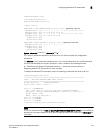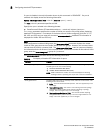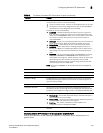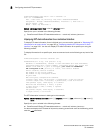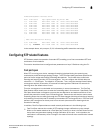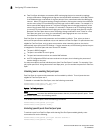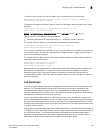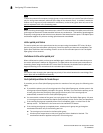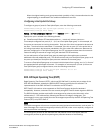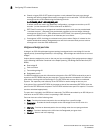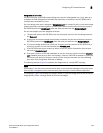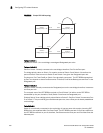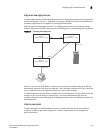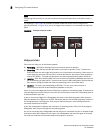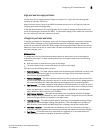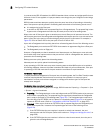
PowerConnect B-Series FCX Configuration Guide 227
53-1002266-01
Configuring STP related features
8
When the original working trunk group comes back (partially or fully), the transition back to the
original topology is accelerated if the conditions listed above are met.
Configuring a Fast Uplink Port Group
To configure a group of ports for Fast Uplink Span, enter the following commands:
PowerConnect(config)# fast uplink-span ethernet 4/1 to 4/4
PowerConnect(config)# write memory
Syntax: [no] fast uplink-span [ethernet <port> [ethernet <port>… | to <port>]]
Specify the <port> variable in the following formats:
• PowerConnect B-Series FCX stackable switches – <stack-unit/slotnum/portnum>
This example configures four ports, 4/1 – 4/4, as a Fast Uplink Span group. In this example, all
four ports are connected to a wiring closet switch. Only one of the links is expected to be active at
any time. The other links are redundant. For example, if the link on port 4/1 is the active link on
the wiring closet switch but becomes unavailable, one of the other links takes over. Because the
ports are configured in a Fast Uplink Span group, the STP convergence takes about four seconds
instead of taking 30 seconds or longer using the standard STP forward delay.
You can add ports to a Fast Uplink Span group by entering the fast uplink-span command
additional times with additional ports. The device can have only one Fast Uplink Span group, so all
the ports you identify as Fast Uplink Span ports are members of the same group.
To remove a Fast Uplink Span group or to remove individual ports from a group, use “no” in front of
the appropriate fast uplink-span command. For example, to remove ports 4/3 and 4/4 from the
Fast Uplink Span group configured above, enter the following commands:
PowerConnect(config)# no fast uplink-span ethernet 4/3 to 4/4
PowerConnect(config)# write memory
802.1W Rapid Spanning Tree (RSTP)
Rapid Spanning Tree Protocol (RSTP), which was 802.1W Draft 3, provided only a subset of the
IEEE 802.1W standard; whereas the 802.1W RSTP feature provides the full standard. The
implementation of the 802.1W Draft 3 is referred to as RSTP Draft 3.
RSTP Draft3 will continue to be supported on Dell PowerConnect devices for backward
compatibility. However, customers who are currently using RSTP Draft 3 should migrate to 802.1W.
The 802.1W feature provides rapid traffic reconvergence for point-to-point links within a few
milliseconds (0 – 500 milliseconds), following the failure of a bridge or bridge port. This
reconvergence occurs more rapidly than the reconvergence provided by the 802.1D Spanning Tree
Protocol (STP)) or by RSTP Draft 3.
NOTE
This rapid convergence will not occur on ports connected to shared media devices, such as hubs. To
take advantage of the rapid convergence provided by 802.1W, make sure to explicitly configure all
point-to-point links in a topology.
The convergence provided by the standard 802.1W protocol occurs more rapidly than the
convergence provided by previous spanning tree protocols because of the following:



